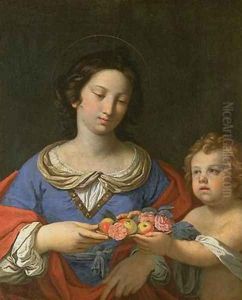Ludovico Lana Paintings
Ludovico Lana was an Italian painter active during the Baroque period, born in 1597 in Modena, Italy. His work is less widely known today compared to other Baroque artists, but he made a considerable contribution to the art of his region in his time.
Lana received his artistic training in the workshop of the prominent painter Guido Reni in Bologna, who was one of the most influential artists of the Baroque period. Reni's classical style and emphasis on clarity and idealized beauty had a strong impact on Lana's developing style. However, Lana did not strictly adhere to his master's approach, and his work also shows the influence of other contemporary artists, including the Carracci family and Domenichino, whose works were characterized by dynamism and emotional expressiveness.
Upon returning to Modena, Ludovico Lana established himself as a painter of religious subjects, portraits, and still lifes. His paintings were known for their delicate color palette and attention to detail. Among his most significant works is the decoration of the ceiling of the church of San Vicenzo in Modena with frescoes, which showcases his skill in large-scale compositions and his ability to create a sense of grandeur. Additionally, he is credited with painting altarpieces for various churches in Modena and its surroundings.
Lana's work also includes a number of portraits, which are valued for their psychological insight and the realistic portrayal of his subjects. He was particularly adept at using light to enhance the three-dimensionality of his figures and to create a focused atmosphere in his compositions. Apart from religious and portrait painting, Lana is somewhat unusually also recognized for his contributions to the genre of still life, which was less typical for Italian artists of the time compared to their Dutch and Flemish contemporaries.
Despite his talents, Ludovico Lana did not achieve widespread fame, and his work was mostly confined to Modena and the surrounding region. His art reflects a transitional period in Italian painting, where the high Baroque style began to give way to the more sober and restrained approach that would characterize the later part of the 17th century.
Ludovico Lana passed away in 1646 in Modena. His works can still be seen in various churches and museums in the region, offering insight into the local artistic landscape of the Baroque period in Italy. While he may not be as well-remembered as some of his contemporaries, his contributions to the art of his time remain a valuable part of the cultural heritage of Modena.
